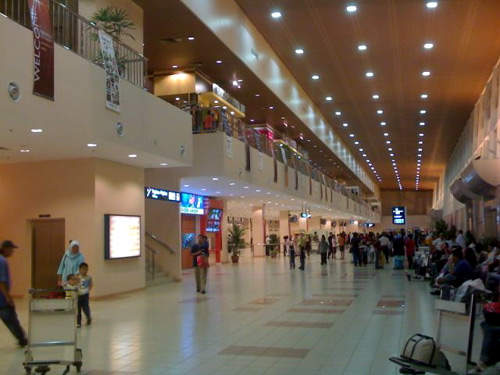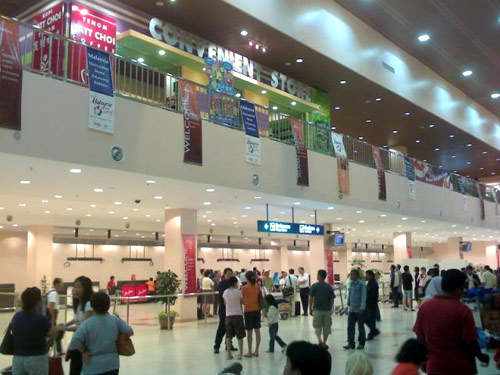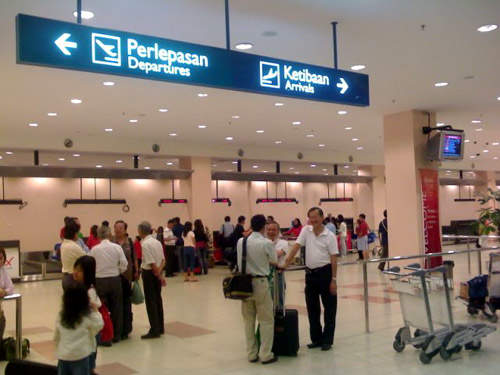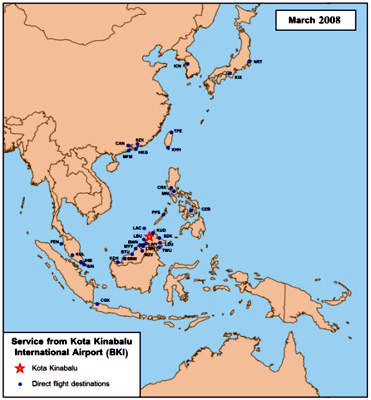Kota Kinabalu International Airport (KKIA) is one of the major airports in Malaysia serving the city of Kota Kinabalu (formerly Jesselton) in the state of Sabah and its urban areas which have a population of around 1.2 million people.
The airport is actually the second busiest in Malaysia, next to Kuala Lumpur International, with 4,399,939 passengers and 52,047 movements in 2007 (the passenger figures include around two million tourists – passenger figures are growing at 5%–8% a year and for the first half of 2008 2,283,304 were recorded).
Conveniently situated around 7km southwest of the central city business district of Kota Kinabalu, the airport has a single runway (02/201) with a length of 2,987m (9,800ft).
Kota Kinabalu International Airport is currently undergoing a major lengthening project to give a new runway length of 3,780m (12,402ft), which is expected to be completed by mid-2009 (there will also be a new control tower).
The public airport is operated by Malaysia Airports Holdings Berhad and regulated by Airport Authority Malaysia Airports. The main contractor at the airport is WCT Engineering Berhad.
New terminal
On 19 August 2008 the airport opened a new two-wing 12-gate terminal building, which will be able to handle around nine million passengers a year (in 2008 4.6 million passengers are expected).
The facility required an investment of R720m ($216m) to construct and has added a number of important facilities to the airport such as two duty-free shops, four retail outlets and four food and drink concessions (Eraman Malaysia will operate the duty-free on level three and Pemborong Bumihijau Duty Free will operate concessions on the landside of level two).
The old 34,000m² (370,000ft²) terminal building, in use since the 1980s, will be demolished during 2009 and then reconstructed as the airport's new domestic terminal with a capacity of three million passengers a year.
The expansion project began in 2006 (authorised by the Malaysian government in 2005) and at the same time the original 1980s terminal had its name changed to terminal 2 (also undergoing renovation) to allow the new terminal to be the main terminal. Total passenger capacity will be 12 million a year when the expansion work is complete. AirAsia now intends to make Kota Kinabalu the main hub for flights from China to Malaysia since it is the nearest Malaysian airport to China.
New KKIA facilities
The new KKIA terminal 1 has three levels (level 1 – 24,128m², level 2 – 18,511.4m² and level 3 – 22,339m²) with a number of lounges for waiting passengers. Passenger capacity for the terminal is 3,200 an hour and there are 750 public seats and 500 trolleys for passenger use.
There are 64 check-in counters which can be used for both domestic and international flights as well as seven luggage X-ray machines (one VIP, three departure, one staff, and two for check-in).
The airport also has 36 immigration counters (16 departures and 20 for arrivals) and also six baggage carousels (70m long, capable of handling 1,200 bags an hour) in the arrivals hall. For loading activities there are 17 aircraft parking bays (wide and narrow aircraft) and 12 aerobridges for loading passengers from the terminal gates.
The new terminal building has been designed to accommodate four B-747s, one A330, seven B-737s, three Fokker 50s and three Dorniers at a single time.
Improvements to the airport itself include new extended transfer piers, new upgraded contact piers, airport main road junction improvements and also a two-tier four-lane separate access road to departure and arrival levels and a new VVIP lounge. There is also a new 1,400-space car park and a new 2,600m² central utility building (CUB).
Terminal 2
Terminal 2 used to be the original terminal building and is located on the other side of the runway from terminal 1. Terminal 2 is now being used for charter and low-cost carriers. Terminal 2 underwent a major renovation and extension during 2006 and opened again in January 2007; it is now to be demolished and reconstructed.
The facility has 26 check-in counters for domestic and international flights, six aircraft parking bays, seven luggage x-ray machines, a VIP room and 13 immigration counters. The renovation was undertaken by Global Upline Sdn Bhd and was completed inside seven months.











